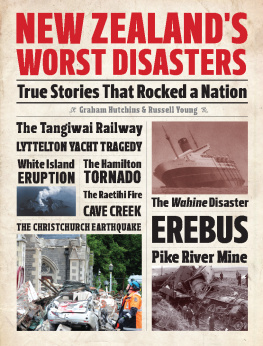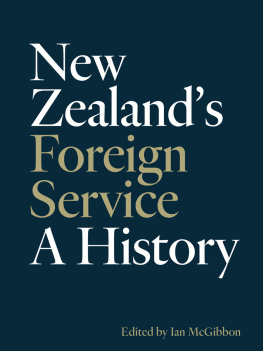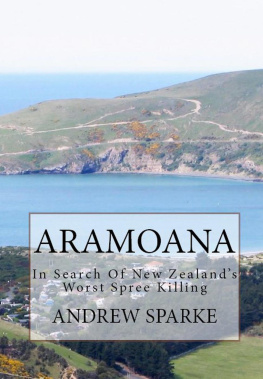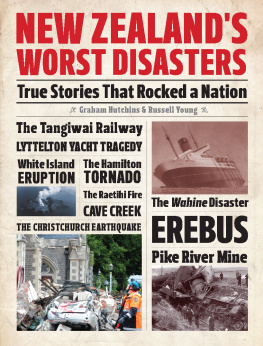Graham Hutchins - New Zealands Worst Disasters
Here you can read online Graham Hutchins - New Zealands Worst Disasters full text of the book (entire story) in english for free. Download pdf and epub, get meaning, cover and reviews about this ebook. year: 2015, publisher: Exisle Publishing, genre: Religion. Description of the work, (preface) as well as reviews are available. Best literature library LitArk.com created for fans of good reading and offers a wide selection of genres:
Romance novel
Science fiction
Adventure
Detective
Science
History
Home and family
Prose
Art
Politics
Computer
Non-fiction
Religion
Business
Children
Humor
Choose a favorite category and find really read worthwhile books. Enjoy immersion in the world of imagination, feel the emotions of the characters or learn something new for yourself, make an fascinating discovery.
- Book:New Zealands Worst Disasters
- Author:
- Publisher:Exisle Publishing
- Genre:
- Year:2015
- Rating:5 / 5
- Favourites:Add to favourites
- Your mark:
- 100
- 1
- 2
- 3
- 4
- 5
New Zealands Worst Disasters: summary, description and annotation
We offer to read an annotation, description, summary or preface (depends on what the author of the book "New Zealands Worst Disasters" wrote himself). If you haven't found the necessary information about the book — write in the comments, we will try to find it.
New Zealands Worst Disasters — read online for free the complete book (whole text) full work
Below is the text of the book, divided by pages. System saving the place of the last page read, allows you to conveniently read the book "New Zealands Worst Disasters" online for free, without having to search again every time where you left off. Put a bookmark, and you can go to the page where you finished reading at any time.
Font size:
Interval:
Bookmark:
A full train plunges into a raging river at Tangiwai; the Wahine is tossed onto rocks at the entrance to Wellington Harbour; an Air New Zealand DC10 plunges into Mt Erebus; an earthquake destroys Christchurch... disasters like these are known to all New Zealanders: they are part of our history, part of our lives. But New Zealand has experienced many more disasters incidents less well known, but shocking, surprising, brutal, bizarre.
Graham Hutchins and Russell Young describe some of the most extraordinary events in New Zealand history. Who knew that a fire killed 39 people at Seacliff Mental Hospital in 1942? That 10 people died in a lahar on White Island in 1914? That a yacht race between Lyttelton and Wellington in 1951 resulted in 10 fatalities? That a tornado ripped through 150 houses in Hamilton in 1948? A fire raging through Raetihi in 1918 was so fierce it destroyed houses, shops and 11 timber mills. Drownings were so common here in the 19th century that they were called the New Zealand death.
These and many other remarkable stories are told in this truly eye-opening book. While it describes accidents and tragedies, it also reveals acts of heroism and valour. For when vulnerable human beings make mistakes, others often achieve superhuman feats of rescue and daring. Some of the stories in this book show that we underestimate Mother Nature at our peril, but many also testify to the courage of the human spirit. Few books are genuine page-turners; this one is.
NEW ZEALANDS
WORST DISASTERS
True Stories that Bocked a Nation


First published 2015
Exisle Publishing Limited,
P.O. Box 60-490, Titirangi, Auckland 0642, New Zealand.
Moonrising, Narone Creek Road, Wollombi, NSW 2325, Australia.
www.exislepublishing.com
Copyright Graham Hutchins and Russell Young 2015
Graham Hutchins and Russell Young assert the moral right
to be identified as the authors of this work.
All rights reserved. Except for short extracts for the purpose
of review, no part of this book may be reproduced, stored in a
retrieval system or transmitted in any form or by any means,
whether electronic, mechanical, photocopying, recording or
otherwise, without prior written permission from the publisher.
A catalogue record for this book is available from
the National Library of New Zealand.
ISBN 978-1-77559-203-7
ePub ISBN 978-1-77559-249-5
Text design and production by IslandBridge
Cover design by Nick Turzynski, redinc
Incidental illustrations from shutterstock.com
Map by Fran Whild
Contents
15 Too much speed: The Hyde rail accident 1943
Introduction
During the course of the past 160 years New Zealand has experienced many disasters, some major, some less so. A number of them are distinctive and rooted in the very character of the country. They have become part of our heritage, and in learning about them we get a glimpse of New Zealands social history as the country evolved into a modern democracy.
Over the years memory dims. The human mind has a propensity for wiping out unpleasant memories. As a result, some disasters have receded down the memory tracks of those who were there or survived them. Not all details are handed down, verbally or in written form. Some remain just hazy recollections. For this reason we felt it important to revive accounts of long-ago tragedies and to acquaint readers with events of which they may not be aware. Out of learning about such adversity we can see how ordinary Kiwis have been able to react positively. As well as the innocent becoming victims, the ordinary can also become heroes. Our short history is peppered with such human transformations. We hope that the lessons learned in earlier disasters will continue to be applied when, inevitably, disaster descends on us again.
Major disasters like the Napier earthquake, the Erebus air accident, the Tangiwai rail disaster and the sinking of the Wahine are not hazy recollections. They remain very much in the public consciousness, often because of the heavy loss of life.
Most New Zealanders can recall where they were and what they were doing when the devastating Christchurch earthquake hit in 2011. It reminded us that disasters can strike with a sudden randomness that destroys our confidence in safety factors installed to prevent or limit the damage caused by such upheavals. Yet Christchurch was not our largest recorded quake. In 1855, a much bigger earthquake shook the southern regions of the North Island and the northern reaches of the South Island. Property damage was serious but very few people lost their lives.
New Zealanders displayed early on a willingness to adapt to their natural environment as best they could. Wild weather and flooding were always going to present challenges. On land, storm systems led to uncommon levels of rainfall which in turn swelled rivers and streams which often broke their banks. Death by drowning was so common here that it became known as the New Zealand death.
Both on land and at sea New Zealanders would be at the mercy of the elements in days when sophisticated weather forecasting was not available. But even in more recent times we could be caught out. The demise of the Wahine occurred in freakish circumstances when two storm systems combined to produce conditions that were unique.
So with the best will in the world, even in a country as supposedly benign as New Zealand, things will go wrong, unusual sets of variables will come into play, Mother Nature will show no mercy and significant disasters will involve or confront us.
As the new country developed its infrastructure, with roads, railways, bridges and larger, safer shipping, it wasnt just the forces of nature that tripped us up. Human error became a factor in either causing the calamity or in not heeding warnings provided by cues of nature. Serious fires and transport accidents often fell into this category.
There were several rail disasters in the years when train travel was a dominant means of getting around. The Tangiwai disaster shocked the nation in 1953 and continues to defy belief.
Then aircraft took to our skies and eventually and perhaps inevitably were represented among New Zealands significant disasters. Some occurred in wartime, others when the skies were clear of enemy hazards. Our worst disaster of any kind happened when 257 people were on a carefree excursion to Antarctica and their plane crashed into Mount Erebus.
From the heights of aircraft in flight to the depths of subterranean mining, New Zealand has also experienced several tragic coal-mining and tunnelling disasters. This collection covers the recent Pike River tragedy and also looks back at 1914s Ralphs Mine explosion in Huntly. There are some common features in both events.
Along the way there have been several distinctive, one-off disasters. Mysterious explosions, dramatic flash-floods and tornadoes have caught us off-guard. And that was when we were going about our everyday business.
Leisure activities have also been the setting for tragedy. Yacht races and pleasure cruises have fallen foul of turbulent seas. Mountain climbing jaunts have gone tragically wrong.
In more recent times there have been disasters that are either distinctly Kiwi or related to activities that have become popular on the back of adventure tourism. Cave Creek became a household name when a viewing platform constructed to enable visitors to view New Zealands pristine native bush environment collapsed.
In a sad irony, 2008s Tongariro canyoning tragedy, when people ventured willingly into what became dangerous waters, echoed the New Zealand death scenario of the pioneering era when so many people drowned because of a lack of roads and bridges.
Next pageFont size:
Interval:
Bookmark:
Similar books «New Zealands Worst Disasters»
Look at similar books to New Zealands Worst Disasters. We have selected literature similar in name and meaning in the hope of providing readers with more options to find new, interesting, not yet read works.
Discussion, reviews of the book New Zealands Worst Disasters and just readers' own opinions. Leave your comments, write what you think about the work, its meaning or the main characters. Specify what exactly you liked and what you didn't like, and why you think so.








